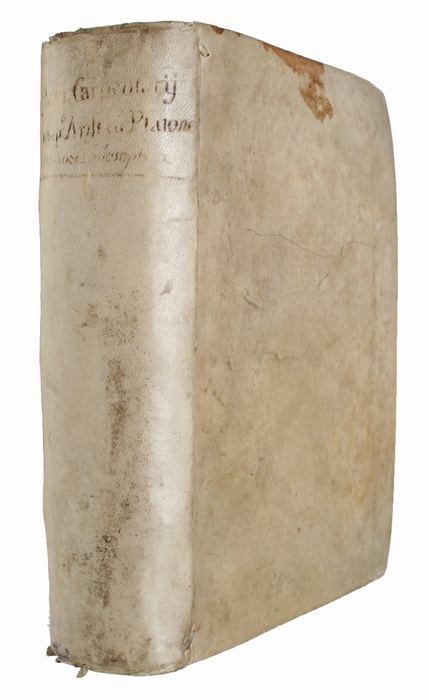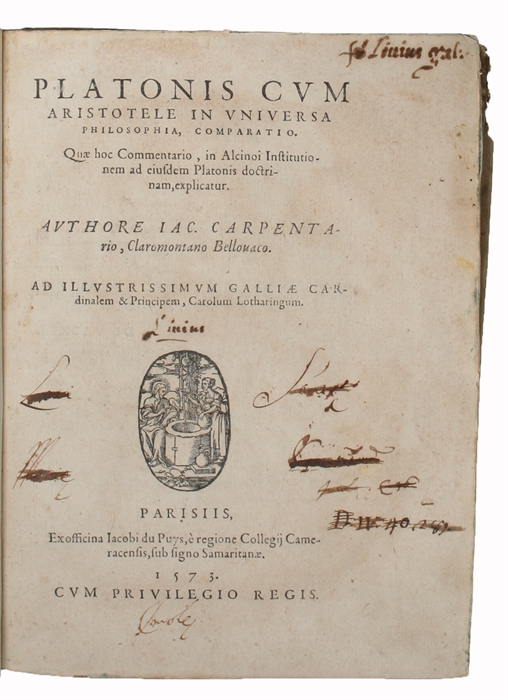UNITING PLATO AND ARISTOTLE - ATTACKING RAMUS
CHARPENTIER
Platonis cum Aristotele in universa philosophia comparatio.Qua hoc Commentario, in Alcinoi Institutionem ad eiusdem Platonis doctrinam, explicatur (+) Pars posterior Platonicae et Aristotelicae comparationis in universa Philosophia. Quae de animorum immortalitate, de fato et libero arbitrio disputationem continet, itemque explicationem eorum, quae ad philosophiam moralem pertinent.
Parisiis, Iacobi du Puys, 1573.
4to. Bound in one near contemporary full vellum. Printers woodcut device to booth title pages. Ex-libris [Luigi Imolae, physician to Pope VII] pasted on to pasted down front free end paper. Title written in contemporary hand to upper part of spine. Names written in contemporary hand and crossed out, except for 'Livius' and 'Imolae', to first title page. Very light uniform browning to leaves. All in all a fine and clean copy. (87), 477, (11), 328, (4) pp.
First edition of Charpentier's famous comparison of Aristotle and Plato - one of the most thorough and important works of its kind - which came to influence the way that the Renaissance viewed the two great thinkers and their works. The work, which is profoundly anti-Ramist and also as such drew great attention, constitutes a fabulous determination of the joint legacy of Aristotle and Plato and is one of the works that best illustrates the nuanced basis of Renaissance scholarship and philosophy.
It is a curious but generally accepted conception that with the rise of the Renaissance came the fall of Aristotle. It is a fact that with the recovery of many lost works of ancient literature, the widening of the range of classical studies and the renewed interest in Plato, Aristotle was no longer the sole authority on a huge number of fields, as he to a certain extent had been viewed during the Middle Ages. That this should mean a total ignorance of the teachings of Aristotle must be considered somewhat of a myth (though a very frequently repeated one), and in fact with the grand humanists of the late 15th and early 16th century, the study of Aristotle fits perfectly with the broader comprehension of scholarship. The idea of nearing the thought of Aristotle to that of Plato and vice-versa is something that understreams much original thought of the Renaissance, and Charpentier's work, which explicitly and thoroughly compares and reconciles the two great thinkers, gives us a fabulous insight into Renaissance thought, as it is rarely presented.
"It was published at Paris in 1573. Charpentier shows a knowledge of other writers in this tradition, namely Boethius, Bessarion, George Trebizond, Giovanni Pico della Mirandola, Symphorien Champier, and Fox Morcillo, among others." (Riccardo Pozzo, "The Impact of Aristotelianism on Modern Philosophy", p. 20).
Jacques Charpentier (1521-74), Professor of medicine and philosophy, Charles IX's physician, taught mathematics at the Collège de France and philosophy at the Collège de Bourgogne and was later appointed Rector of the University of Paris. He passionately defended Peripateticism and was renowned for his philosophical and religious intolerance. Despite his remarkable merits he is today perhaps best known for his feud with Petrus Ramus, French humanist and protestant convert with a liberal approach to Aristotelian teaching. In Ramus Charpentier saw the impact of Lorenzo Valla's criticism or Aristotle: "He thought that with Ramus the true idea of knowledge was in danger of eclipse", as expressed in the present work. Charpentier is often referred to as a Anti-Ramist due to his many - often fierce and personal - attacks on Ramus's teaching:
"More intellectual provocative were three attacks by Jacques Charpentier. In 1551 as rector of the University Charpentier ruled that because Ramus did not teach the Aristotelian logic required by the statutes, his pupils could not enjoy the privileges of Paris university students. Rasmus appealed first to the assembly of regents of Philosophy and later to the Parliament of Paris. Before the Parliament Ramus outlined a programme of study in which grammar, rhetoric, and dialectic led first to natural and moral philosophy and later theology or law. He argued that his method of teaching avoided wasting time on scholastic technicalities and produced graduates who were better prepared for practical life. The effectiveness of this speech and the support of his patron helped him to avoid censure and obtain a royal lectureship." (Mack, A History of Renaissance Rhetoric 1380-1620, Pp. 153-4).
"by 1565 he was leading opposition to the naming of Jacques Charpentier (no relation), a long-time adversary, to the royal chair of mathematics. Charpentier, who had by then succeeded Ramus as the Cardinal de Lorraine's protégé and who enjoyed Jesuit support, kept his chair; and Ramus, ever more threatened, in 1567 again fled Paris, taking refuge with the Prince de Condé." (DSB).
Order-nr.: 47259




